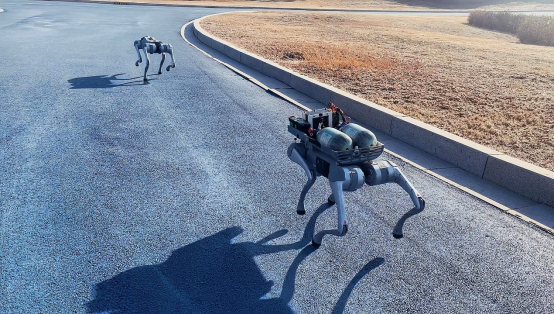- Home
- OFweek News
- Next-Gen Robotics: Hydrogen Fuel Cells Power Robot Dog to Record-Breaking Performance
Next-Gen Robotics: Hydrogen Fuel Cells Power Robot Dog to Record-Breaking Performance
Published: February 20, 2025 10:42
In a groundbreaking test conducted in Jinan, Shandong Province, China's first hydrogen fuel cell-powered robot dog has demonstrated remarkable endurance capabilities. The trial, which employed a comparative "dual-dog walking" methodology, took place during Jinan's winter conditions. The hydrogen-powered quadruped achieved an impressive 4-hour runtime covering 11.89 kilometers, while its lithium battery-powered counterpart managed only 1 hour and 12 minutes with a range of 5.08 kilometers. This significant improvement addresses a critical limitation in robot dog technology: insufficient operational endurance for demanding applications.
The innovative hydrogen-powered robot dog was developed by Jiyi Wings (Jinan) Hydrogen Technology Co., Ltd. (Jiyi Wings), featuring their proprietary hydrogen fuel cell system integrated into a modified Unitree Go2 AIR platform. According to Liu Haining, General Manager of Jiyi Wings, this implementation represents a significant milestone, transitioning hydrogen fuel cell robotics from concept to reality in China. The convergence of hydrogen power—often termed the "future energy"—with the rapidly evolving quadruped robot sector potentially marks the beginning of a new era in robot dog endurance capabilities.
Addressing Critical Endurance Limitations
Quadruped robots, commonly known as robot dogs, offer superior flexibility, terrain adaptability, payload capacity, and stability compared to bipedal robots. Their versatility makes them ideal for military, firefighting, inspection, security patrol, and domestic companion applications. Their competitive size and cost advantages position them as potential leaders in military robotics procurement. The Growth Giant Industrial Institute (GGII) projects China's quadruped robot market to reach nearly 400,000 units by 2030, with a compound annual growth rate exceeding 50% from 2024 to 2030.
However, widespread adoption in challenging operational scenarios requires significant improvements in endurance, payload capacity, and intelligence. Contemporary lithium battery-powered robot dogs typically operate for only 2-4 hours, insufficient for extended, high-intensity missions. Increasing battery capacity means adding weight and volume, compromising mobility and payload capabilities.
source: Jiyi Wings
Cost-Effective Innovation
The hydrogen fuel cell system developed by Jiyi Wings boasts a 300W power output, utilizing a 35MPa rated hydrogen storage tank with a 770L maximum capacity. The system operates effectively between -5°C and 40°C. Test results showed static standing endurance of 7-8 hours and dynamic walking endurance of 4-5 hours—more than double the performance of lithium battery systems.
Remarkably, operating costs are projected at less than 0.15 yuan per kilometer. Using Dezhou, Shandong as an example, where hydrogen costs 25 yuan per kilogram, the system requires approximately 30-40 grams of hydrogen for a full charge, costing roughly 1 yuan. This efficiency, combined with declining hydrogen prices in regions like Guangdong and Henan, suggests strong commercial viability.
Future Implications
Building on this success, Jiyi Wings plans to explore hydrogen fuel cell applications in humanoid robots, industrial drones, logistics drones, wilderness monitoring equipment, and mobile power supplies. This expansion could accelerate hydrogen energy adoption across robotics and aerospace industries, potentially worth hundreds of billions of yuan, while supporting China's national energy transition goals.
The development represents a significant step forward in both robotics and sustainable energy technology, potentially opening new avenues for extended-duration autonomous operations in challenging environments.

